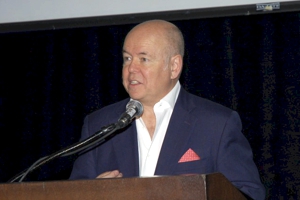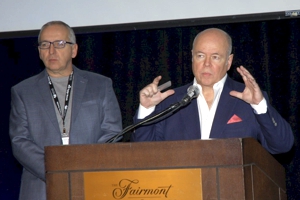Terry O'Reilly: Perceptions can be changed, but not easily
Date posted: January 13, 2017

Terry O'Reilly
Ad man, radio personality and marketing guru Terry O'Reilly spoke to a packed room at the 2017 Banff Pork Seminar, and shared his belief that any negative perception of a brand can be changed.
How do you change a negative perception in the marketplace? "A negative perception can be changed if you have a great insight, a really smart leverage point and if you are absolutely consistent with your messaging from that point on," says O'Reilly.
Brand
O'Reilly defines brand as what an organization stands for, and possibly more importantly, what it stands against. For example Nike says "Just Do It" - and is against being a couch potato. "In another words it is a crystal clear vision of what makes you unique, and what you stand against usually says more about your organization."
Using Einstein as an example, O'Reilly explained why the perception of a brand is so important. Einstein was one of many important scientists in the 20th century but likely the only one most people can name. He is perceived to be the greatest scientist of his time because his brand has become so well known. And perceptions are sticky.
Perceptions: burrs on a sweater
"Perceptions are sticky little things. They are like burrs on a wool sweater, they are tough to remove," says O'Reilly. Advertising's goal is to build perceptions for a product or organization. A positive perception makes price less important, and banks goodwill.
"If your brand is unique, compelling and well defined, and people feel positively about it, they will listen to your messages, respect your industry and buy your product," says O'Reilly.
If the perception of a brand is unclear, it fogs up the messaging and identity and impacts perception. "In this time-starved world the perception of a brand acts like shorthand. It is an impression we carry with us," says O'Reilly. If the perception of a brand is working against its identity, then it is time to change the perception.
Marlboro Country
"Changing a perception is the most difficult task you can give to marketing because people treat them like possessions. They don't part with them easily," says O'Reilly.
Using the example of Marlboro cigarettes, he explained how the cigarettes were considered a ladies' product, and were failing in the marketplace. The ad agency decided to try to change the conversation about the product to attract male consumers and the Marlboro man was born.
It was around this time that marketers realized the consumers quite often "drink the label and smoke the advertising. The image of the brand hinges on the perception of the product, not the actual product qualities themselves. The perception of a brand is an idea, and because it is an idea it could be influenced," says O'Reilly.
The Marlboro campaign, what O'Reilly describes as perhaps advertising's darkest success story, was nevertheless a useful marketing success case study because it influenced how people perceived the product and changed the conversation completely.
"Changing the conversation is never easy. It takes insights, strategic planning and patience. But it can be done," he says.
I love New York
In order to change the conversation a leverage point is also needed. "A leverage point is something already in the consumers' minds that is so persuasive it cannot be denied" he says. A great example of this was the campaign in the 1980's to try and revive the image of New York City to attract tourists, despite its reputation as dirty and unsafe.
After consulting focus groups, it became clear that Broadway was the one thing people loved about NYC and that became the leverage point of the campaign. It overrode all the other perceptions people had about the city. "This is a great example of how finding the greatest area of opportunity when you are fighting a perception problem can change the conversation. The 'I love NYC' campaign wasn't about the city. It was about Broadway."
"When you uncover a leverage point, it's like rocket fuel."
Leave your bias at the door
Finding that rocket fuel isn't easy says O'Reilly. An organization must be Switzerland, completely neutral when doing research and looking for the leverage point. "You must let the research reveal itself. Do not stickhandle the results or let your biases impress the results." In his experience, he has usually been surprised at how wrong his assumptions were.

Frank Novak, (left) session chair hosts questions for Terry O'Reilly
The key is asking the right questions and listening closely to the answers. Quite often it goes back to what the perception of the product is and asking the right question can reveal the insight.
Process, not event
Patience is needed. "You can change a perception but it is a delicate process. You have to be absolutely consistent in your messaging. You need patience because changing a perception is not an event. It's a process. It takes time." And lastly O'Reilly says, "If you want people to think about you in new ways, you need to talk to them in new ways."
The first step in changing a perception is to dig for the insight. To look for meaning not just facts.
"Your brand in the pork industry is so important and so powerful and it is one of your most valuable assets. And like anything of value it needs care and nurturing and it needs to be protected," says O'Reilly. He adds that when changing the perception or conversation around the pork industry seems insurmountable, remember New York City.
Return to the News Release Index
